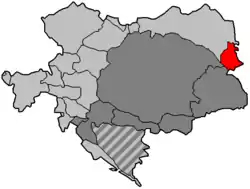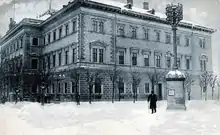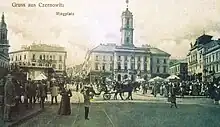Duchy of Bukovina
The Duchy of Bukovina (German: Herzogtum Bukowina or Herzogtum Buchenland; Romanian: Ducatul Bucovinei; Ukrainian: Герцогство Буковина) was a constituent land of the Austrian Empire from 1849 and a Cisleithanian crown land of Austria-Hungary from 1867 until 1918.
Duchy of Bukovina | |||||||||
|---|---|---|---|---|---|---|---|---|---|
| 1849–1918 | |||||||||
 Coat of arms
| |||||||||
 The Duchy of Bukovina within Austria-Hungary | |||||||||
| Status | Land of the Austrian Empire (1849–1867) Crown land of Cisleithania (1867–1918) | ||||||||
| Capital | Czernowitz (Cernăuți / Chernivtsi) | ||||||||
| Common languages | German, Romanian, Ukrainian | ||||||||
| Government | Constitutional Monarchy (1861–1918) | ||||||||
| Landespräsident | |||||||||
• 1849 | Eduard von Bach | ||||||||
• 1917–1918 | Josef Graf von Ezdorf | ||||||||
| History | |||||||||
• Annexation of northwestern Moldavia by the Habsburg monarchy[1][2][3] and integration into the Kingdom of Galicia and Lodomeria as the Bukovina District | 1775 | ||||||||
• Establishment of the Duchy of Bukovina | March 4, 1849 | ||||||||
| November 28, 1918 | |||||||||
| September 10, 1919 | |||||||||
| Area | |||||||||
• Total | 10,442 km2 (4,032 sq mi) | ||||||||
| |||||||||
| Today part of | Romania Ukraine | ||||||||
Name
The name Bukovina came into official use in 1775 with the region's annexation from the Principality of Moldavia to the possessions of the Habsburg monarchy (which became the Austrian Empire in 1804, and Austria-Hungary in 1867).
The official German name, die Bukowina, of the province under Austrian rule (1775–1918), was derived from the Polish form Bukowina, which in turn was derived from the Ukrainian word, Буковина (Bukovyna), and the common Slavic form of buk, meaning beech tree (бук [buk] as, for example, in Ukrainian or, even, Buche in German).[4][5] Another German name for the region, das Buchenland, is mostly used in poetry, and means "beech land", or "the land of beech trees". In Romanian, in literary or poetic contexts, the name Țara Fagilor ("the land of beech trees") is sometimes used.
In English, an alternative form is The Bukovina, increasingly an archaism, which, however, is found in older literature.
History
After the Mongol invasion of Europe, the Bukovina lands since the 14th century had been part of the Principality of Moldavia, with Suceava being the princely capital from 1388 to 1565. In the 16th century, Moldavia came under Ottoman suzerainty, but still retaining its autonomy.[6] During the early 18th century, Moldavia became the target of the Russian Empire's southwards expansion, inaugurated by Tsar Peter the Great during the Pruth River Campaign of 1710–11. In 1769, during the Russo-Turkish War of 1768–74, Moldavia was occupied by the Imperial Russian Army.
Austrian rule

Following the First Partition of Poland in 1772, the Habsburg monarchy had aimed at a land connection from the Principality of Transylvania to the newly acquired Kingdom of Galicia and Lodomeria. After the Russo-Turkish Treaty of Küçük Kaynarca was concluded in July 1774, the Austrians entered into negotiations with the Sublime Porte from October and could finally obtain a territory of Moldavia with an area of about 10,000 square kilometres (ca. 4,000 square miles) they called Bukowina, which they formally annexed in January 1775. On 2 July 1776, at Palamutka, Austrians and Ottomans signed a border convention, the Habsburg monarchy giving back 59 of the previously occupied villages, and remaining with 278 villages. For opposing and protesting the annexation of the northwestern part of Moldavia, the Moldavian ruler Prince Grigore III Ghica was assassinated by the Ottomans.[7][8]
Bukovina at first was a closed military district from 1775 until 1786, and then was incorporated as the largest district, the Bukovina District, of the Austrian constituent Kingdom of Galicia and Lodomeria. So far, the Moldavian nobility had traditionally formed the ruling class in that territory. The Habsburg emperor Joseph II wished to affiliate the region with the provinces of the Austrian monarchy (though not with the Holy Roman Empire); he had the devastated lands colonised by Danube Swabians, later known as Bukovina Germans. In the mid 19th century the town of Sadhora became the centre of the Hasidic Sadigura dynasty. The immigration process promoted the further economic development of the multi-ethnic country, though it remained a remote eastern outpost of the Danube Monarchy.

In 1804, the region became part of the newly established Austrian Empire. After the political turmoil of the 1848 revolutions, the estates urged the Vienna government to elevate the Bukovina to a separate Austrian Kronland (crown land). With effect of 4 March 1849, the former Kreis was declared the Herzogtum Bukowina, a nominal duchy as part of the official full style of the Austrian emperor. It was governed by a k.k. Statthalter (stadtholder) appointed by the emperor, with his official residence at Czernowitz from 1850.
In 1860 the Bukovina was again amalgamated with Galicia, but reinstated as a separate province once again according to the 1861 February Patent issued by Emperor Franz Joseph I. The reinstated crown land received its own Landtag diet including a Landesausschuss executive authority, a status that would last until 1918.[9] In 1867, with the re-organisation of the Austrian Empire as the Austro-Hungarian Empire, it became part of the Cisleithanian ("Austrian") territories. Upon the promulgation of the December Constitution, the Imperial Council, on the initiative of the Cisleithanian Citizens' Ministry led by Karl von Auersperg, decided to confer the title Landespräsident on the former stadtholder, heading a Landesregierung (state government). Nine (from 1907 elections: 14) delegates represented the Bukovina in the Austrian House of Deputies.
First World War
The main military force in the region during peacetime was the 22nd Infantry Regiment at Czernowitz, at that time the only k.k. Landwehr regiment with a Romanian majority (54%). As soon as hostilities began, however, new units were formed from the locally recruited population. The 22nd, 23rd and 41st Landwehr Regiments, along with the 4th Dragoons regiment all had Romanian majority.[10][11] To encourage recruitment, the Romanians were allowed to wear their national colors as well as receiving spiritual guidance by ethnic-Romanian military priests.[12]
In 1914–15 large parts of the Bukovina were occupied by the Russian 8th Army under General Aleksei Brusilov after the Austro-Hungarian defeat in the Battle of Galicia and could only be regained by the united forces of the Central Powers after the German-led Gorlice–Tarnów Offensive and the Russian Great Retreat. The Romanian troops fought bravely, 62 being awarded the Medal for Bravery. In one instance, the 41st Regiment fought for 54 hours continuously.[13] By 4 June 1916, The Bukovinian Romanian casualties were 184 killed, 1175 wounded and 82 captured.[14]
In the autumn of 1918, the multi-ethnic state of Austria-Hungary collapsed and the Ministry of War officially ordered demobilization, though no central authority was able to ensure the decommissioning of arms. On 18 October 1918, the Ukrainian National Council established in Lemberg, Galicia, planned to declare a Ukrainian Republic that would also incorporate the Bukovina and Carpathian Ruthenia.[15] On 25 October 1918, a Ukrainian regional committee, led by Emilian Popowicz, was established in Czernowitz to represent the Ukrainian National Council in Bukovina.[15] On 14/27 October 1918, at the initiative of Sextil Pușcariu, Iancu Flondor, and Isidor Bodea, the Constituent Assembly of Bukovina established, in Czernowitz, the Romanian National Council (consisting of representatives from the Austrian parliament and from the Bukovina diet, and local political activists), which adopted a declaration to support the union of Bukovina with Romania, and demanded the last Austrian Landespräsident governor Josef Graf Etzdorf to cede his power.[16]
In the meantime, the local paramilitary forces of the Ukrainian National Council took control over Czernowitz and other parts of Bukovina, effectively supplanting Austrian control by the 6th of November. Although local Ukrainians attempted to incorporate Bukovina into the so-called West Ukrainian People's Republic, they were not able to set up an administration.[9] In the light of Ukrainians' actions, the Romanian National Council leader Iancu Flondor, request the Romanian government to intervene in Bukovina. Five days later, the Romanian 8th Division, led by General Iacob Zadik, entered Czernowitz,[16] against Ukrainian protests,[17][18] while the Ukrainian paramilitary forces withdrew without resistance to Galicia.[15] Further attempts by local Ukrainians to incorporate parts of northern Bukovina into the West Ukrainian People's Republic were swiftly suppressed by the troops, with the leadership of the Ukrainian National Council fleeing across the Dniester River, to Galicia, which was partially under Ukrainian military control.[9][15]
After the Romanian troops secured the region, a General Congress of Bukovina was established on 15/28 November 1918, which counted among its members 74 Romanians, 13 Ruthenians, 7 Germans, and 6 Poles were elected (this is the linguistic composition, and Jews were not recorded as a separate group). A popular enthusiasm sprang throughout the region, and a large number of people gathered in the city to wait for the resolution of the Congress.[19] The Congress elected the Romanian Bukovinian politician Iancu Flondor as chairman, and voted for the union with the Kingdom of Romania, with the support of the Romanian, German, and Polish representatives; Ukrainian representatives boycotted the Congress.[20][21] The reasons stated were that, until its takeover by the Habsburg in 1775, Bukovina was the heart of the Principality of Moldavia (where the voivods' burial sites are located), and right of self-determination.[22][23]
Romanian control of the province was recognized internationally in the Treaty of St. Germain, in 1919, and the Treaty of Trianon, in 1920, when both the Republic of German-Austria and the Kingdom of Hungary renounced all claims to the Bukovina.
Administration

When Kreis Bukowina was elevated to a duchy in its own right in 1849, it was initially still administered from the Galician capital Lemberg. By order of the Austrian Ministry of the Interior, Czernowitz became the seat of an Imperial-Royal (k.k.) stadtholder in 1850. By the 1861 February Patent the Duchy of Bukovina got a representative assembly, the Landtag diet with a Landesausschuss executive branch led by a Landeshauptmann. Upon the 1907 Cisleithanian legislative election the duchy was represented by 14 delegates in the Austrian Imperial Council legislature.
The subdivision of the crown land was amended in 1868; by 1914 the Duchy of Bukovina consisted of eleven political districts (Bezirke):
| District | Area | Pop. (1900) |
|---|---|---|
| Czernowitz | 876.05 km2 (338.24 sq mi) | 99,438 |
| Gurahumora (est. 1893) | 739.89 km2 (285.67 sq mi) | 55,741 |
| Kimpolung | 2,349.48 km2 (907.14 sq mi) | 55,688 |
| Kotzmann | 518.80 km2 (200.31 sq mi) | 94,633 |
| Radautz | 184.097 km2 (71.080 sq mi) | 82,152 |
| Sereth | 518.8 km2 (200.3 sq mi) | 60,743 |
| Storoschinetz | 1,152.31 km2 (444.91 sq mi) | 80,100 |
| Suczawa | 569.32 km2 (219.82 sq mi) | 62,447 |
| Waskoutz am Czeremosz (est. 1903) | 427.87 km2 (165.20 sq mi) | 43,595 |
| Wysznitz | 1,499.89 km2 (579.11 sq mi) | 71,631 |
| Zastawna (est. 1905) | 492.82 km2 (190.28 sq mi) | 51,502 |
Historical population
According to the 1775 Austrian census, the province had a total population of 86,000 (this included 56 villages which were later returned to Moldova). The census only recorded social status and some ethno-religious groups. In 1919, the historian Ion Nistor claimed that Romanians constituted an overwhelming majority in 1774, roughly 64,000 (85%) of the 75,000 total population. Meanwhile, about 8,000 (10%) were Ruthenians, and 3,000 (4%) other ethnic groups.[24] On the other hand, just four years before the same Nistor claimed the 1774 population consisted of 52,750 Romanians (73%), 15.000 Ruthenians (21%) and 4,000 others "using Romanian in conversation" (6%).[25] In 2011, an anthropological analysis of the Russian census of the population of Moldova in 1774 asserted a population of 68,700 people in 1774, out of which 40,920 (59.6%) Romanians, 22,810 Ruthenians and Hutsuls (33.2%), and 7.2% Jews, Roma, and Armenians.[26] The Ruthenians lived more densely in the north-west of Bukovina, especially in the zone between Prut and Dniester and the Hutsuls were concentrated in the mountain zone in the west of the province, especially in the zone of the rivers Ceremuș and Putyla. In 1787, the imperial officials documented in Czernowitz 414 houses, of which 153 Moldavian (Romanian), 84 German, 76 Jewish, with the rest being Armenian, Arnaut (Albanian), Czech, Greek, Hungarian, Pole and Ruthene (Ukrainian).[7][27]
During the 19th century, the Austrian Empire policies encouraged the influx of many immigrants (Austrian authorities encouraged immigration in order to develop the economy[28]), mainly Ukrainians (at that time referred to as Ruthenians from Galicia) and Romanians from Transylvania and Hungary, as well as smaller numbers of Germans, Poles, Jews, and Hungarians.[29] Official censuses in the Austrian Empire (later Austria-Hungary) did not record ethno-linguistic data until 1850–1851. H.F. Müller gives the 1840 population used for purposes of military conscription as 339,669.[30] According to Alecu Hurmuzaki, by 1848 55% of the population was Romanian. The Austrian census of 1850–1851 which for the first time recorded data regarding languages spoken, shows 48.50% Romanians and 38.07% Ruthenians[31]
In 1843 the Ruthenian language was recognized, along with the Romanian language, as 'the language of the people and of the Church in Bukovina'.[29]
According to estimates and the census data of Austria-Hungary, the population of Bukovina was:
| Year | Romanians | Ruthenians (Ukrainians) | Others (including, most notably, Bukovina Germans) | |||
|---|---|---|---|---|---|---|
| 1774.[24][26] | 40,920 – 64,000 | 59.6% – 85.33% | 8,000 – 22,810 | 10.6% – 33.2% | 3,000 – 4,970 | 4.0% – 7.2% |
| 1848[24] | 209,293 | 55.4% | 108,907 | 28.8% | 59,381 | 15.8% |
| 1851[32] | 184,718 | 48.5% | 144,982 | 38.1% | 51,126 | 13.4% |
| 1880[33] | 190,005 | 33.4% | 239,960 | 42.2% | 138,758 | 24.4% |
| 1890[34] | 208,301 | 32.4% | 268,367 | 41.8% | 165,827 | 25.8% |
| 1900[35] | 229,018 | 31.4% | 297,798 | 40.8% | 203,379 | 27.8% |
| 1910 | 273,254 | 34.1% | 305,101 | 38.4% | 216,574 | 27.2% |
References
- "History of Bukovina, Dr. Sophie A. Welisch (publ 2002)". Archived from the original on 23 September 2015. Retrieved 20 January 2017.
- "The Bukovina-Germans During the Habsburg Period" (PDF). Archived from the original (PDF) on 2015-09-05. Retrieved 2015-12-02.
- Charles King (1 September 2013). The Moldovans: Romania, Russia, and the Politics of Culture. Hoover Press. pp. 21–. ISBN 978-0-8179-9793-9.
- "Bukovyna". Retrieved 20 January 2017.
- "Painted monasteries of Southern Bucovina – Brasov Travel Guide". Retrieved 20 January 2017.
- Kemal H. Karpat (January 2002). Studies on Ottoman Social and Political History: Selected Articles and Essays. BRILL. pp. 403–. ISBN 90-04-12101-3.
- Marcel Cornis-Pope; John Neubauer (13 September 2006). History of the Literary Cultures of East-Central Europe: Junctures and disjunctures in the 19th and 20th centuries. John Benjamins Publishing Company. pp. 62–. ISBN 978-90-272-9340-4.
- Grigore Ghica III, ucis pentru că s-a împotrivit cedării Bucovinei (in Romanian)
- Paul R. Magocsi (2010). A History of Ukraine: The Land and Its Peoples. University of Toronto Press. ISBN 978-1-4426-1021-7.
- Bucovina în anii primului război mondial, Fetcu, 2004, p. 221
- Botezul focului și al nemuririi în Bucovina anilor 1914–1918, Cozmiuc, 2015, p. 4
- Participarea clerului ortodox bucovinean la Primul Război Mondial și Unirea Românilor din 1918, Cutui, p. 52
- "Unirea: Triumful României, nicidecum al Bucovinei". dragusanul.ro (in Romanian). Retrieved 2023-04-16.
- "Bucovineni căzuţi şi răniţi pe câmpul de luptă". dragusanul.ro (in Romanian). Retrieved 2023-04-16.
- West Ukrainian National Republic and Polish-Ukrainian War
- Integrarea Bucovinei in cadrul Romaniei intregite (1918–1940). Aspecte ligislative (in Romanian)
- Rus, Ionas Aurelian (2008). Variables Affecting Nation-Building: The Impact Of The Ethnic Basis, The Educational System, Industrialization And Sudden Shocks. p. 133. ISBN 9781109059632.
- Bukovyna, Encyclopedia of Ukraine
- Ion Bulei, Scurta istorie a românilor, Editura Meronia, Bucuresti, 1996, pp. 104–107
- Minoritatea ucraineana din Romania (1918–1940) Archived 2015-10-17 at the Wayback Machine
- Constantin Kiriţescu (1989). Istoria războiului pentru întregirea României: 1916 – 1919. Ed. S̨tiint̨ifică s̨i Enciclopedică. ISBN 978-973-29-0048-2.
- "Congresul general al Bucovinei, intrupand suprema putere a tarii si fiind investiti cu puterea legiuitoare, in numele suveranitatii nationale, hotaram: Unirea neconditionata si pe vecie a Bucovinei in vechile ei hotare pana la Ceremuş, Colacin si Nistru cu Regatul Romaniei". The General congress of Bukovina, embodying the supreme power of the country [Bukovina], and invested with legislative power, in the name of national sovereignty, we decide: Unconditional and eternal union of Bukovina, in its old boundaries up to Ceremuş [river], Colachin and Dniester [river] with the Kingdom of Romania.
- The Union Act of Bukovina with Romania (15/28 November 1918) (in Romanian)
- Keith Hitchins. The Romanians 1774–1866. Oxford: Clarendon Press (1996), pp. 226
- Nistor, Ion (1915). Românii și rutenii în Bucovina. Bucharest: Romanian Academy. pp. 70–72.
- Ungureanu, Constantin (2011). "Die Bevölkerung der Bukowina (von Besetzung im Jahr 1774 bis zur Revolution 1848)". Romanian Journal of Population Studies (in German). 5 (1): 117–143. ISSN 1843-5998.
- Braun, Helmut (2013). Czernowitz : die Geschichte einer untergegangenen Kulturmetropole (3., aktualisierte Aufl. ed.). Berlin: Links. p. 34. ISBN 9783861537502.
- Raimund Friedrich Kaindl. Das Ansiedlungswesen in der Bukowina seit der Besitzergreifung durch Österreich. Innsbruck (1902), pp. 1–71
- Bukovina Handbook, prepared under the Direction of the Historical Section of the British Foreign Office No.6. Published in London, Feb.1919.
- Müller, H F (1848). Die Bukowina im Königreiche Galizien (in German). Wien: H.F. Müller's Kunsthandlung. p. 9. Retrieved 2014-06-05.
- 1855 Austrian ethnic-map showing census data in lower right corner
- 1855 Austrian ethnic-map showing 1851 census data in lower right corner File:Ethnographic map of austrian monarchy czoernig 1855.jpg
- First Austro-Hungarian census measuring the 'language spoken at home' of the population
- Austro-Hungarian census of 1890
- Austro-Hungarian census of 1900
External links
- The Bukovina Society of the Americas
- Valentina Glajar (1 January 2004). The German Legacy in East Central Europe as Recorded in Recent German-language Literature. Camden House. pp. 13–. ISBN 978-1-57113-256-7.
